Researchers document that acupuncture produces higher pregnancy rates than fertility medications for women with hyperprolactinemia (HPL).
Acupuncture produces a higher rate of pregnancies than fertility medications with significantly less adverse effects. In a controlled clinical trial, researchers document that acupuncture outperforms bromocriptine and bromocriptine plus clomiphene for the treatment of infertility for women with hyperprolactinemia (HPL). Acupuncture produced a 43.3% pregnancy rate whereas fertility medications produced 20% pregnancy rate.
One important mechanism responsible for the fertility treatment success with acupuncture is hormonal regulation. Acupuncture more rapidly normalized levels of prolactin than fertility medications. In hyperprolactinemia, elevated levels of prolactin (PRL) hormone causes infertility by inhibiting gonadotropin-releasing hormone (GnRH) production. GnRH is responsible for stimulating gonadotropins (Gn), luteinising hormone (LH), and follicle-stimulating hormone (FSH) production. As a result, hyperprolactinemia affects the overall function of the ovaries, ovulation, and corpus luteum formation because Gn, LH, and FSH play an important biological role in reproductive health.
The study (Hu et al.) confirms that acupuncture normalizes prolactin levels more rapidly than receiving bromocriptine or bromocriptine plus clomiphene. Patients receiving acupuncture averaged a normalization of prolactin levels within two weeks. Patients receiving bromocriptine or bromocriptine plus clomiphene experienced normalization of prolactin levels within four weeks. The research indicates that acupuncture produces a faster homeostatic response for prolactin production in women with hyperprolactinemia.
One significant advantage to acupuncture treatment for the treatment of fertility emerged; acupuncture did not produce a high adverse effect rate. Conversely, fertility medications produced a high adverse effect rate. Patients receiving bromocriptine or bromocriptine plus clomiphene had a 63.33% adverse effect rate.
Overall, there is a wealth of information indicating that acupuncture is successful in promoting reproductive health. Pregnancy rates increase accompanied by measurable improvements in hormonal regulation. Additional research is warranted based on the evidence.
References:
Hu J, Yan XL & Wang ZX. (2014). Acupuncture and Bromocriptine in the Treatment of Special HPL in Infertile Women. Journal of Clinical Acupuncture and Moxibustion. 30(7).
Zhang P. (2012). Bromocriptine in treating hyperprolactinemia. Journal of Jingchu University of Technology. 24(7): 50-52.
Hullender Rubin, Lee E., Michael S. Opsahl, Lisa Taylor-Swanson, and Deborah L. Ackerman. “Acupuncture and In Vitro Fertilization: A Retrospective Chart Review.” The Journal of Alternative and Complementary Medicine (2013).
Zhongguo Zhen Jiu. 2012 Feb;32(2):113-6. Effects of electroacupuncture on embryo implanted potential for patients with infertility of different symptom complex]. Kong FY, Zhang QY, Guan Q, Jian FQ, Sun W, Wang Y. Department of Reproduction, The Second Affiliated Hospital of Shandong University of TCM, Jinan, China.
Xu, Yin, and Miao Zhang. Efficacy observation on 40 cases of anovulatory infertility treated by acupuncture and moxibustion. World Journal of Acupuncture-Moxibustion 23, no. 1 (2013): 40-43.



